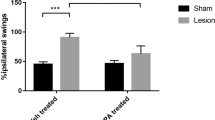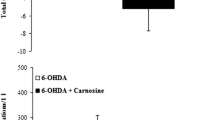Abstract
Parkinson’s disease (PD) is a neurodegenerative disorder characterized by the degeneration of dopaminergic nigrostriatal neurons. Although the etiology of the majority of human PD cases is unknown, experimental evidence points to oxidative stress as an early and causal event. Probucol is a lipid-lowering phenolic compound with anti-inflammatory and antioxidant properties that has been recently reported as protective in neurotoxicity and neurodegeneration models. This study was designed to investigate the effects of probucol on the vulnerability of striatal dopaminergic neurons to oxidative stress in a PD in vivo model. Swiss mice were treated with probucol during 21 days (11.8 mg/kg; oral route). Two weeks after the beginning of treatment, mice received a single intracerebroventricular (i.c.v.) infusion of 6-hydroxydopamine (6-OHDA). On the 21st day, locomotor performance, striatal oxidative stress-related parameters, and striatal tyrosine hydroxylase and synaptophysin levels, were measured as outcomes of toxicity. 6-OHDA-infused mice showed hyperlocomotion and a significant decrease in striatal tyrosine hydroxylase (TH) and synaptophysin levels. In addition, 6-OHDA-infused mice showed reduced superoxide dismutase activity and increased lipid peroxidation and catalase activity in the striatum. Notably, probucol protected against 6-OHDA-induced hyperlocomotion and striatal lipid peroxidation, catalase upregulation and decrease of TH levels. Overall, the present results show that probucol protects against 6-OHDA-induced toxicity in mice. These findings may render probucol as a promising molecule for further pharmacological studies on the search for disease-modifying treatment in PD.




Similar content being viewed by others
References
Lang AE, Lozano AM (1998) Parkinson’s disease. First of two parts. N Engl J Med 339(15):1044–1053. doi:10.1056/NEJM199810083391506
Meissner WG (2012) When does Parkinson’s disease begin? From prodromal disease to motor signs. Rev Neurol (Paris). doi:10.1016/j.neurol.2012.07.004
Spica V, Pekmezovic T, Svetel M, Kostic VS (2012) Prevalence of non-motor symptoms in young-onset versus late-onset Parkinson’s disease. J Neurol. doi:10.1007/s00415-012-6600-9
Hirsch E, Graybiel AM, Agid YA (1988) Melanized dopaminergic neurons are differentially susceptible to degeneration in Parkinson’s disease. Nature 334(6180):345–348. doi:10.1038/334345a0
Schapira AH (2008) Progress in Parkinson’s disease. Eur J Neurol 15(1):1. doi:10.1111/j.1468-1331.2007.02036.x
Obeso JA, Rodriguez-Oroz MC, Goetz CG, Marin C, Kordower JH, Rodriguez M, Hirsch EC, Farrer M, Schapira AH, Halliday G (2010) Missing pieces in the Parkinson’s disease puzzle. Nat Med 16(6):653–661. doi:10.1038/nm.2165
Steece-Collier K, Maries E, Kordower JH (2002) Etiology of Parkinson’s disease: genetics and environment revisited. Proc Natl Acad Sci USA 99(22):13972–13974. doi:10.1073/pnas.242594999
Jenner P (2003) Oxidative stress in Parkinson’s disease. Ann Neurol 53(Suppl 3):S26–S36. doi:10.1002/ana.10483 (discussion S36–S28)
Zhou C, Huang Y, Przedborski S (2008) Oxidative stress in Parkinson’s disease: a mechanism of pathogenic and therapeutic significance. Ann NY Acad Sci 1147:93–104. doi:10.1196/annals.1427.023
Lotharius J, Brundin P (2002) Pathogenesis of Parkinson’s disease: dopamine, vesicles and alpha-synuclein. Nat Rev Neurosci 3(12):932–942. doi:10.1038/nrn983
Graham DG, Tiffany SM, Bell WR Jr, Gutknecht WF (1978) Autoxidation versus covalent binding of quinones as the mechanism of toxicity of dopamine, 6-hydroxydopamine, and related compounds toward C1300 neuroblastoma cells in vitro. Mol Pharmacol 14(4):644–653
Fukae J, Mizuno Y, Hattori N (2007) Mitochondrial dysfunction in Parkinson’s disease. Mitochondrion 7(1–2):58–62. doi:10.1016/j.mito.2006.12.002
Henchcliffe C, Beal MF (2008) Mitochondrial biology and oxidative stress in Parkinson disease pathogenesis. Nat Clin Pract Neurol 4(11):600–609. doi:10.1038/ncpneuro0924
Langston JW (1996) The etiology of Parkinson’s disease with emphasis on the MPTP story. Neurology 47(6 Suppl 3):S153–S160
Chinta SJ, Andersen JK (2008) Redox imbalance in Parkinson’s disease. Biochim Biophys Acta 1780(11):1362–1367. doi:10.1016/j.bbagen.2008.02.005
Martin HL, Teismann P (2009) Glutathione–a review on its role and significance in Parkinson’s disease. FASEB J 23(10):3263–3272. doi:10.1096/fj.08-125443
Bove J, Perier C (2011) Neurotoxin-based models of Parkinson’s disease. Neuroscience 211:51–76. doi:10.1016/j.neuroscience.2011.10.057
Glinka Y, Gassen M, Youdim MB (1997) Mechanism of 6-hydroxydopamine neurotoxicity. J Neural Transm Suppl 50:55–66
Kumar R, Agarwal AK, Seth PK (1995) Free radical-generated neurotoxicity of 6-hydroxydopamine. J Neurochem 64(4):1703–1707
Saner A, Thoenen H (1971) Model experiments on the molecular mechanism of action of 6-hydroxydopamine. Mol Pharmacol 7(2):147–154
Group TPS (1993) Effects of tocopherol and deprenyl on the progression of disability in early Parkinson’s disease. N Engl J Med 328(3):176–183. doi:10.1056/NEJM199301213280305
Shults CW, Oakes D, Kieburtz K, Beal MF, Haas R, Plumb S, Juncos JL, Nutt J, Shoulson I, Carter J, Kompoliti K, Perlmutter JS, Reich S, Stern M, Watts RL, Kurlan R, Molho E, Harrison M, Lew M (2002) Effects of coenzyme Q10 in early Parkinson disease: evidence of slowing of the functional decline. Arch Neurol 59(10):1541–1550
Yamashita S, Hbujo H, Arai H, Harada-Shiba M, Matsui S, Fukushima M, Saito Y, Kita T, Matsuzawa Y (2008) Long-term probucol treatment prevents secondary cardiovascular events: a cohort study of patients with heterozygous familial hypercholesterolemia in Japan. J Atheroscler Thromb 15(6):292–303
Champagne D, Pearson D, Dea D, Rochford J, Poirier J (2003) The cholesterol-lowering drug probucol increases apolipoprotein E production in the hippocampus of aged rats: implications for Alzheimer’s disease. Neuroscience 121(1):99–110
Park SY, Lee JH, Kim CD, Rhim BY, Hong KW, Lee WS (2007) Beneficial synergistic effects of concurrent treatment with cilostazol and probucol against focal cerebral ischemic injury in rats. Brain Res 1157:112–120. doi:10.1016/j.brainres.2007.04.051
Santos DB, Peres KC, Ribeiro RP, Colle D, dos Santos AA, Moreira EL, Souza DO, Figueiredo CP, Farina M (2012) Probucol, a lipid-lowering drug, prevents cognitive and hippocampal synaptic impairments induced by amyloid beta peptide in mice. Exp Neurol 233(2):767–775. doi:10.1016/j.expneurol.2011.11.036
Colle D, Hartwig JM, Soares FA, Farina M (2012) Probucol modulates oxidative stress and excitotoxicity in Huntington’s disease models in vitro. Brain Res Bull 87:397–405. doi:10.1016/j.brainresbull.2012.01.003
Farina M, Campos F, Vendrell I, Berenguer J, Barzi M, Pons S, Sunol C (2009) Probucol increases glutathione peroxidase-1 activity and displays long-lasting protection against methylmercury toxicity in cerebellar granule cells. Toxicol Sci 112(2):416–426. doi:10.1093/toxsci/kfp219
Tanaka K, Ogawa N, Asanuma M (2006) Molecular basis of 6-hydroxydopamine-induced caspase activations due to increases in oxidative stress in the mouse striatum. Neurosci Lett 410(2):85–89. doi:10.1016/j.neulet.2006.08.021
Laursen SE, Belknap JK (1986) Intracerebroventricular injections in mice. Some methodological refinements. J Pharmacol Methods 16(4):355–357
Prediger RD, Medeiros R, Pandolfo P, Duarte FS, Passos GF, Pesquero JB, Campos MM, Calixto JB, Takahashi RN (2008) Genetic deletion or antagonism of kinin B(1) and B(2) receptors improves cognitive deficits in a mouse model of Alzheimer’s disease. Neuroscience 151(3):631–643. doi:10.1016/j.neuroscience.2007.11.009
Moreira EL, Rial D, Duarte FS, de Carvalho CR, Horst H, Pizzolatti MG, Prediger RD, Ribeiro-do-Valle RM (2010) Central nervous system activity of the proanthocyanidin-rich fraction obtained from Croton celtidifolius in rats. J Pharm Pharmacol 62(8):1061–1068. doi:10.1111/j.2042-7158.2010.01124.x
Carlberg I, Mannervik B (1985) Glutathione reductase. Methods Enzymol 113:484–490
Wendel A (1981) Glutathione peroxidase. Methods Enzymol 77:325–333
Aebi H (1984) Catalase in vitro. Methods Enzymol 105:121–126
Misra HP, Fridovich I (1972) The role of superoxide anion in the autoxidation of epinephrine and a simple assay for superoxide dismutase. J Biol Chem 247(10):3170–3175
Ohkawa H, Ohishi N, Yagi K (1979) Assay for lipid peroxides in animal tissues by thiobarbituric acid reaction. Anal Biochem 95(2):351–358
Bradford MM (1976) A rapid and sensitive method for the quantitation of microgram quantities of protein utilizing the principle of protein-dye binding. Anal Biochem 72:248–254
Kostrzewa RM, Reader TA, Descarries L (1998) Serotonin neural adaptations to ontogenetic loss of dopamine neurons in rat brain. J Neurochem 70(3):889–898
Reader TA, Dewar KM (1999) Effects of denervation and hyperinnervation on dopamine and serotonin systems in the rat neostriatum: implications for human Parkinson’s disease. Neurochem Int 34(1):1–21
Janero DR (1990) Malondialdehyde and thiobarbituric acid-reactivity as diagnostic indices of lipid peroxidation and peroxidative tissue injury. Free Radic Biol Med 9(6):515–540
Mates JM, Perez-Gomez C, Nunez de Castro I (1999) Antioxidant enzymes and human diseases. Clin Biochem 32(8):595–603
Dringen R, Hirrlinger J (2003) Glutathione pathways in the brain. Biol Chem 384(4):505–516. doi:10.1515/BC.2003.059
Kumer SC, Vrana KE (1996) Intricate regulation of tyrosine hydroxylase activity and gene expression. J Neurochem 67(2):443–462
Dexter DT, Carter CJ, Wells FR, Javoy-Agid F, Agid Y, Lees A, Jenner P, Marsden CD (1989) Basal lipid peroxidation in substantia nigra is increased in Parkinson’s disease. J Neurochem 52(2):381–389
Alam ZI, Jenner A, Daniel SE, Lees AJ, Cairns N, Marsden CD, Jenner P, Halliwell B (1997) Oxidative DNA damage in the parkinsonian brain: an apparent selective increase in 8-hydroxyguanine levels in substantia nigra. J Neurochem 69(3):1196–1203
Alam ZI, Daniel SE, Lees AJ, Marsden DC, Jenner P, Halliwell B (1997) A generalised increase in protein carbonyls in the brain in Parkinson’s but not incidental Lewy body disease. J Neurochem 69(3):1326–1329
Floor E, Wetzel MG (1998) Increased protein oxidation in human substantia nigra pars compacta in comparison with basal ganglia and prefrontal cortex measured with an improved dinitrophenylhydrazine assay. J Neurochem 70(1):268–275
Di Matteo V, Esposito E (2003) Biochemical and therapeutic effects of antioxidants in the treatment of Alzheimer’s disease, Parkinson’s disease, and amyotrophic lateral sclerosis. Curr Drug Targets CNS Neurol Disord 2(2):95–107
Beal MF (2001) Experimental models of Parkinson’s disease. Nat Rev Neurosci 2(5):325–334. doi:10.1038/35072550
Cohen G (1984) Oxy-radical toxicity in catecholamine neurons. Neurotoxicology 5(1):77–82
Soto-Otero R, Mendez-Alvarez E, Hermida-Ameijeiras A, Munoz-Patino AM, Labandeira-Garcia JL (2000) Autoxidation and neurotoxicity of 6-hydroxydopamine in the presence of some antioxidants: potential implication in relation to the pathogenesis of Parkinson’s disease. J Neurochem 74(4):1605–1612
Ungerstedt U (1971) Postsynaptic supersensitivity after 6-hydroxy-dopamine induced degeneration of the nigro-striatal dopamine system. Acta Physiol Scand Suppl 367:69–93
Dringen R (2005) Oxidative and antioxidative potential of brain microglial cells. Antioxid Redox Signal 7(9–10):1223–1233. doi:10.1089/ars.2005.7.1223
Dringen R, Pawlowski PG, Hirrlinger J (2005) Peroxide detoxification by brain cells. J Neurosci Res 79(1–2):157–165. doi:10.1002/jnr.20280
Ghosh N, Ghosh R, Mandal SC (2011) Antioxidant protection: a promising therapeutic intervention in neurodegenerative disease. Free Radic Res 45(8):888–905. doi:10.3109/10715762.2011.574290
Baud O, Greene AE, Li J, Wang H, Volpe JJ, Rosenberg PA (2004) Glutathione peroxidase-catalase cooperativity is required for resistance to hydrogen peroxide by mature rat oligodendrocytes. J Neurosci 24(7):1531–1540. doi:10.1523/JNEUROSCI.3989-03.2004
Mozaffar S, Ueda M, Kitatsuji K, Shimizu S, Osumi M, Tanaka A (1986) Properties of catalase purified from a methanol-grown yeast, Kloeckera sp. 2201. Eur J Biochem 155(3):527–531
Farina M, Frizzo ME, Soares FA, Schwalm FD, Dietrich MO, Zeni G, Rocha JB, Souza DO (2003) Ebselen protects against methylmercury-induced inhibition of glutamate uptake by cortical slices from adult mice. Toxicol Lett 144(3):351–357
McCord JM, Fridovich I (1988) Superoxide dismutase: the first twenty years (1968–1988). Free Radic Biol Med 5(5–6):363–369
Oh SH, Lim SC (2006) A rapid and transient ROS generation by cadmium triggers apoptosis via caspase-dependent pathway in HepG2 cells and this is inhibited through N-acetylcysteine-mediated catalase upregulation. Toxicol Appl Pharmacol 212(3):212–223. doi:10.1016/j.taap.2005.07.018
Terland O, Flatmark T, Tangeras A, Gronberg M (1997) Dopamine oxidation generates an oxidative stress mediated by dopamine semiquinone and unrelated to reactive oxygen species. J Mol Cell Cardiol 29(6):1731–1738. doi:10.1006/jmcc.1997.0412
Bridges AB, Scott NA, Belch JJ (1991) Probucol, a superoxide free radical scavenger in vitro. Atherosclerosis 89(2–3):263–265
Kalyanaraman B, Darley-Usmar VM, Wood J, Joseph J, Parthasarathy S (1992) Synergistic interaction between the probucol phenoxyl radical and ascorbic acid in inhibiting the oxidation of low density lipoprotein. J Biol Chem 267(10):6789–6795
Ebadi M, Sharma SK (2003) Peroxynitrite and mitochondrial dysfunction in the pathogenesis of Parkinson’s disease. Antioxid Redox Signal 5(3):319–335. doi:10.1089/152308603322110896
Jenner P, Olanow CW (1996) Oxidative stress and the pathogenesis of Parkinson’s disease. Neurology 47(6 Suppl 3):S161–S170
Yamashita S, Matsuzawa Y (2009) Where are we with probucol: a new life for an old drug? Atherosclerosis 207(1):16–23. doi:10.1016/j.atherosclerosis.2009.04.002
Acknowledgments
The financial supports by (1) Conselho Nacional de Desenvolvimento Científico e Tecnológico (CNPq), (2) IBN.NET/CNPq, (3) PRONEX-CNPq/FAPESC (NENASC project), (4) Coordenação de Aperfeiçoamento de Pessoal de Nível Superior (CAPES) and (5) INCT-CNPq-Excitotoxicity and Neuroprotection are gratefully acknowledged. M.F. and C.P.F. are recipients of CNPq fellowships.
Conflict of interest
The authors have no financial or personal conflicts of interest related to this work.
Author information
Authors and Affiliations
Corresponding authors
Rights and permissions
About this article
Cite this article
Ribeiro, R.P., Moreira, E.L.G., Santos, D.B. et al. Probucol Affords Neuroprotection in a 6-OHDA Mouse Model of Parkinson’s Disease. Neurochem Res 38, 660–668 (2013). https://doi.org/10.1007/s11064-012-0965-0
Received:
Revised:
Accepted:
Published:
Issue Date:
DOI: https://doi.org/10.1007/s11064-012-0965-0




